To maintain perfect water-saving habits, regularly inspect your plumbing for leaks and repair them promptly, as small drips waste lots of water. Clean fixtures like aerators and showerheads to guarantee efficient flow, and check your water pressure to prevent leaks and damage. Drain your water heater annually and maintain toilet components for ideal operation. Manage your landscape wisely with smart watering techniques, and stay vigilant with water bill monitoring—all these steps help you save water consistently.
Key Takeaways
- Conduct regular plumbing inspections and promptly repair leaks to prevent water waste and damage.
- Clean fixtures and aerators regularly, and upgrade to water-efficient devices for optimal flow control.
- Monitor and adjust water pressure using gauges and pressure-reducing valves to prevent pipe and appliance damage.
- Maintain toilets by inspecting seals and replacing worn parts to ensure efficient flushing and minimize leaks.
- Use smart timers, landscape mulching, and drought-tolerant plants to optimize outdoor water use and detect leaks early.
Regularly Inspect and Repair Leaks
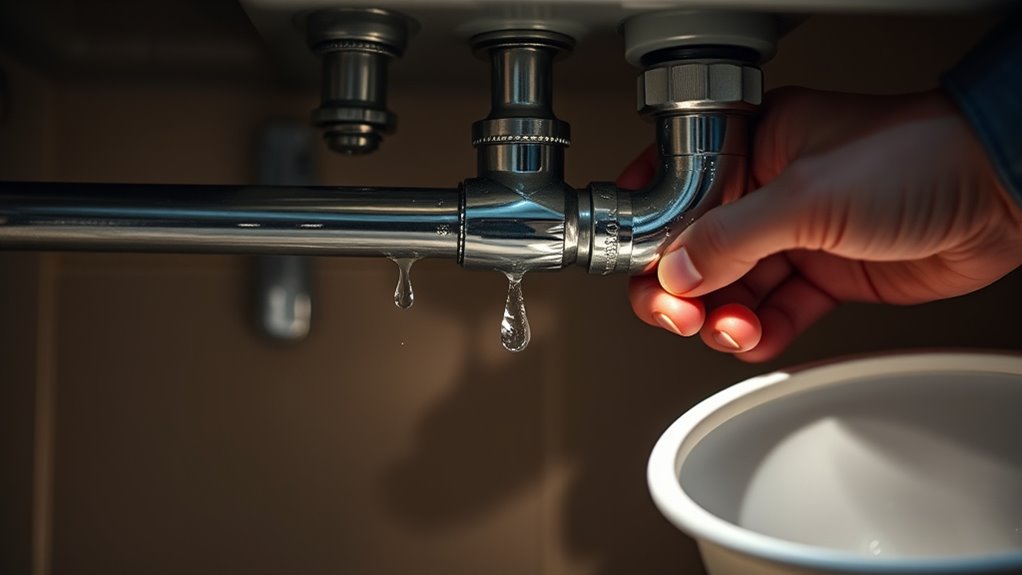
Leaks can waste a significant amount of water if left unchecked. Regularly inspecting your plumbing helps catch leaks early through effective leak detection, preventing water loss. Look for signs like damp spots, mold, or a sudden increase in your water bill. Pay close attention to pipes, fittings, and joints, especially in hidden areas. Proper pipe insulation can prevent freezing and reduce the risk of cracks that cause leaks. If you notice a leak, repair it promptly to conserve water and avoid costly damage. Don’t ignore small drips—they can quickly escalate into major issues. Consistent inspections and timely repairs keep your plumbing efficient, saving water and money in the long run. Staying proactive ensures your home remains leak-free and water-smart.
Clean and Maintain Your Faucets and Showerheads
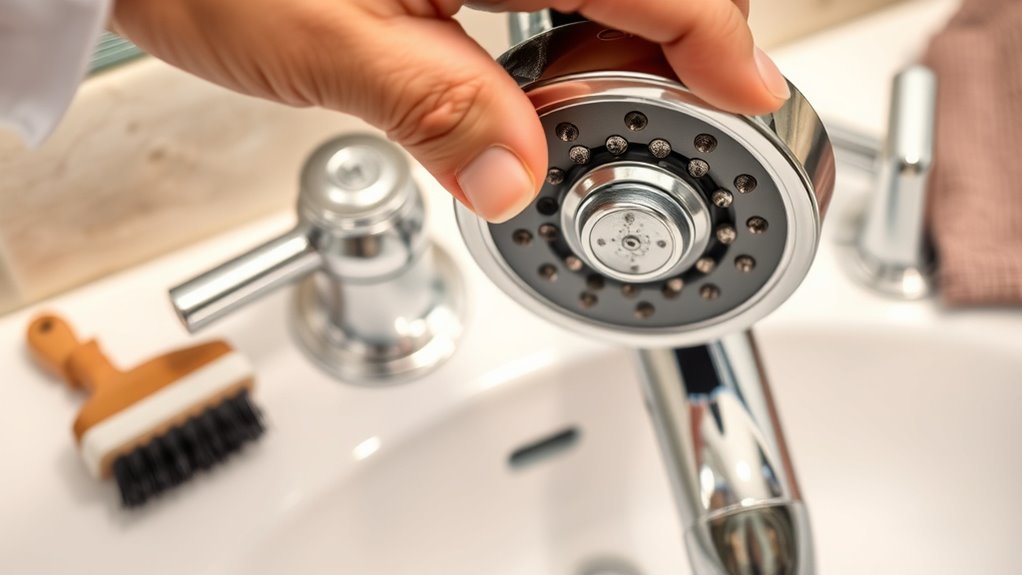
Regularly cleaning and maintaining your faucets and showerheads guarantees they operate efficiently and use less water. Use eco-friendly materials for cleaning, like vinegar or baking soda, to avoid harsh chemicals. If you have smart faucet technology, verify it’s updated and functioning properly to maximize water savings. Check for mineral buildup or leaks, which can reduce flow and waste water. Here’s a quick overview:
| Step | Task | Notes |
|---|---|---|
| 1 | Remove and clean aerators | Use eco-friendly cleaners to prevent damage |
| 2 | Check for leaks | Tighten fittings or replace faulty parts |
| 3 | Clean showerheads | Soak in vinegar to dissolve deposits |
| 4 | Upgrade to smart technology | Increase efficiency and control |
Maintaining these fixtures helps conserve water effortlessly.
Check and Adjust Water Pressure
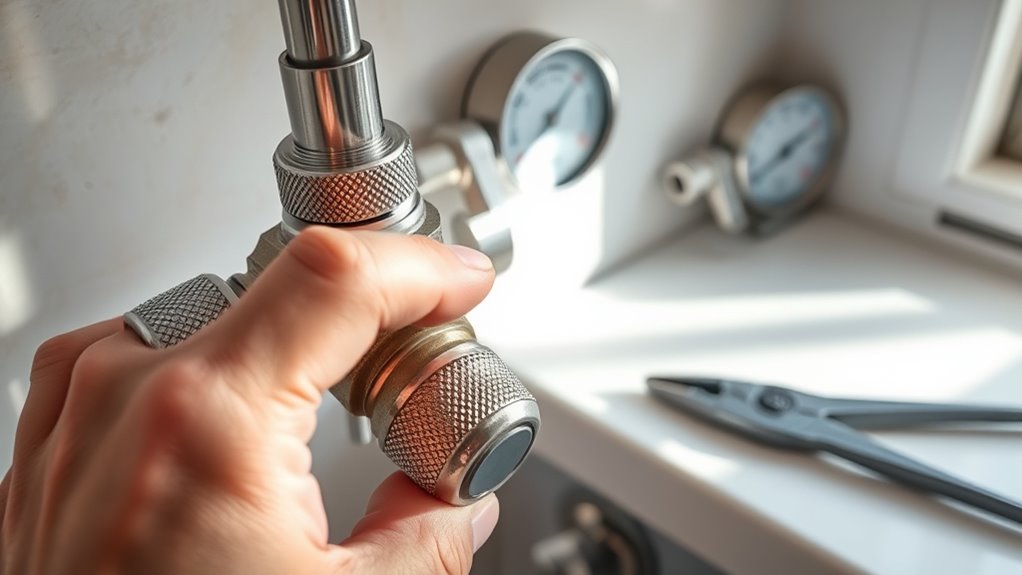
To guarantee you’re using water efficiently, it’s important to check and adjust your water pressure regularly. Proper pressure regulation ensures your fixtures work effectively without wasting water. Use a pressure gauge to measure your home’s water pressure; ideal pressure is typically between 40 and 60 psi. If it’s too high, consider installing a pressure-reducing valve to prevent leaks and excessive flow. For flow rate adjustments, you can turn down the flow restrictors on fixtures like showerheads and faucets. Lowering the flow rate reduces water consumption without sacrificing performance. Regularly monitoring and adjusting your water pressure helps prevent damage to pipes and appliances, saving you money and conserving water. Stay proactive to maintain excellent pressure and maximize your water-saving efforts.
Drain and Flush Your Water Heater Annually
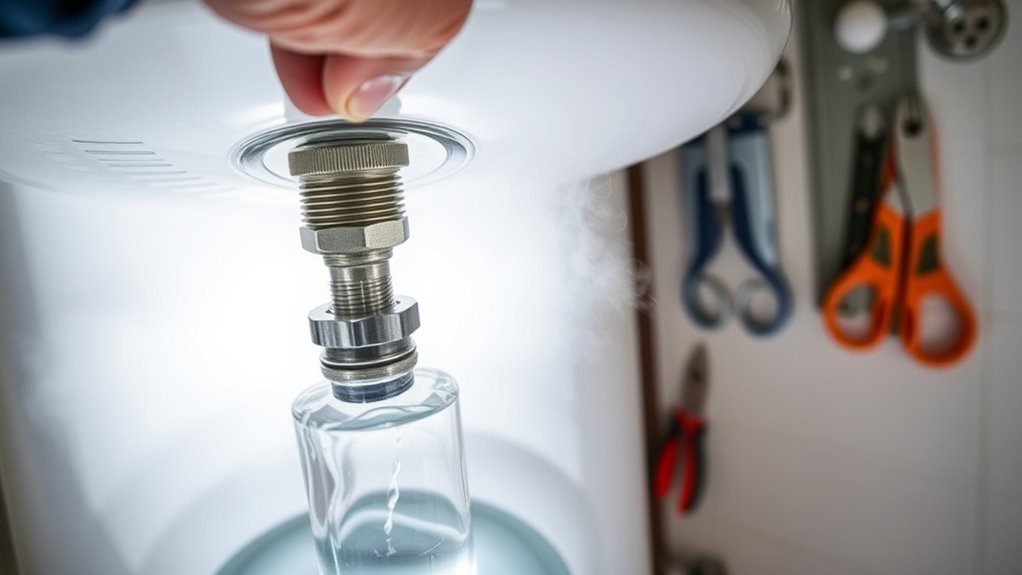
Regularly draining and flushing your water heater helps prevent sediment buildup, which can reduce efficiency and lifespan. I’ll guide you through the simple steps to do this and show you how it benefits your system. Keeping your heater clean guarantees you save water and energy in the long run.
Benefits of Annual Drainage
Flushing your water heater annually offers significant benefits, including improved efficiency and a longer lifespan for the appliance. Regular drainage prevents mineral buildup, ensuring your heater runs smoothly and conserves energy—helping you save on utility bills. Additionally, by maintaining your water heater, you reduce the risk of leaks and costly repairs. This maintenance also supports eco-friendly practices like garden irrigation and rainwater harvesting by ensuring your water system operates *ideally*, minimizing waste. When your water heater functions properly, it uses less energy and water, contributing to overall water conservation efforts. Plus, a well-maintained appliance provides reliable hot water for everyday needs, making your household more sustainable and efficient. Regular drainage is a simple step toward better water management and savings.
Step-by-Step Flushing Guide
Performing an annual drain and flush on your water heater is a straightforward process that helps maintain its efficiency and extend its lifespan. First, turn off the power supply and close the cold water inlet. Attach a garden hose to the drain valve and direct it to a drain or bucket. Open the drain valve to let sediment and mineral buildup escape. During this, check your water filter and clean or replace it if needed. Also, inspect pipe insulation around the heater to ensure it’s intact, preventing heat loss. After draining, briefly open the cold water supply to flush out residual debris, then close everything securely. Regular maintenance like this keeps your water heater running smoothly, reduces energy costs, and supports water-saving efforts.
Preventing Sediment Buildup
Sediment buildup inside your water heater can reduce its efficiency and lead to higher energy costs. Over time, sediment accumulation from minerals in your water settles at the bottom, clouding water clarity and hampering heating performance. To prevent this, you should drain and flush your water heater annually. This process removes sediment before it builds up enough to cause problems. Regular flushing keeps the tank clean, improves water clarity, and ensures your heater operates efficiently. It also prolongs the lifespan of the unit and maintains consistent hot water supply. Make it a routine part of your maintenance schedule to avoid costly repairs and maximize water and energy savings. A simple annual drain and flush can considerably reduce sediment accumulation and keep your water heater running smoothly.
Maintain and Replace Toilet Components as Needed
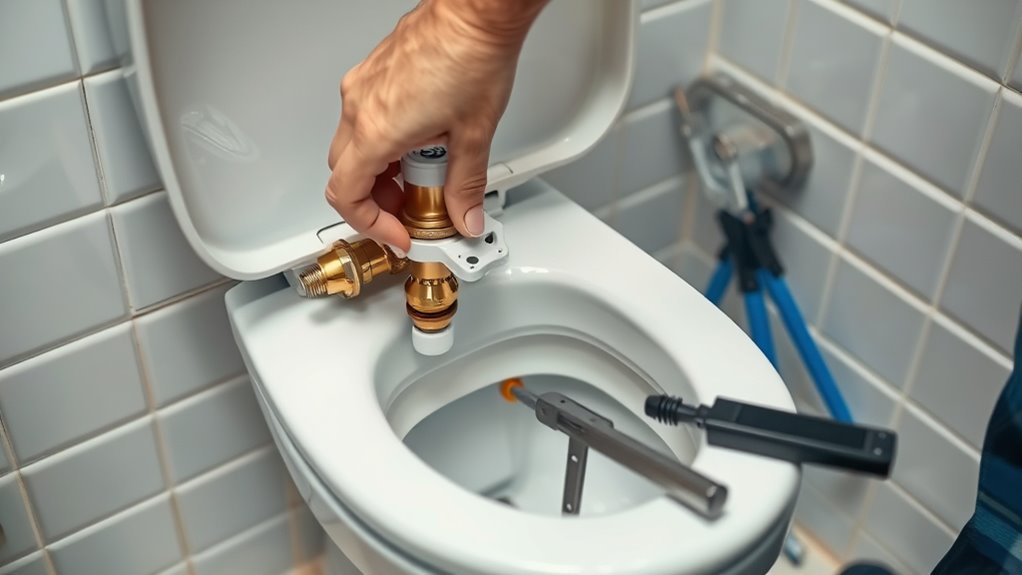
You should regularly check the flapper seal to prevent leaks and save water. Worn or damaged toilet parts need replacement to guarantee efficient operation. Staying on top of these maintenance tasks helps you conserve water and avoid costly repairs.
Check Flapper Seal Regularly
Since a worn or damaged flapper seal can cause your toilet to waste water, it’s important to check it regularly. Perform a seal inspection by lifting the flapper and observing for cracks or deterioration. If you notice any damage, a quick flapper replacement can prevent leaks and save water.
- Look for signs of mineral buildup or debris on the flapper
- Ensure the flapper sits snugly against the flush valve
- Replace the flapper if it doesn’t form a tight seal or shows wear
Regularly inspecting your flapper helps maintain efficient operation and prevents unnecessary water usage. Keeping the seal in good condition is a simple step towards a more water-conscious household and reduces your utility bills.
Replace Worn Toilet Parts
Regularly inspecting and replacing worn toilet parts guarantees your toilet functions efficiently and conserves water. Over time, components like the flapper, fill valve, or flush valve can wear out, leading to leaks or inefficient flushing. Performing simple toilet repair and component replacement ensures your toilet operates properly, reducing water waste. If you notice constant running or a weak flush, it’s time to check and replace the damaged parts. Using quality replacement parts and following proper installation procedures can extend your toilet’s lifespan and improve its water-saving performance. Don’t ignore signs of wear; addressing these issues promptly minimizes water bills and prevents more extensive repairs later. Maintaining your toilet with regular component replacement guarantees smooth operation and *maximum* water conservation.
Install and Use Water-Efficient Fixtures
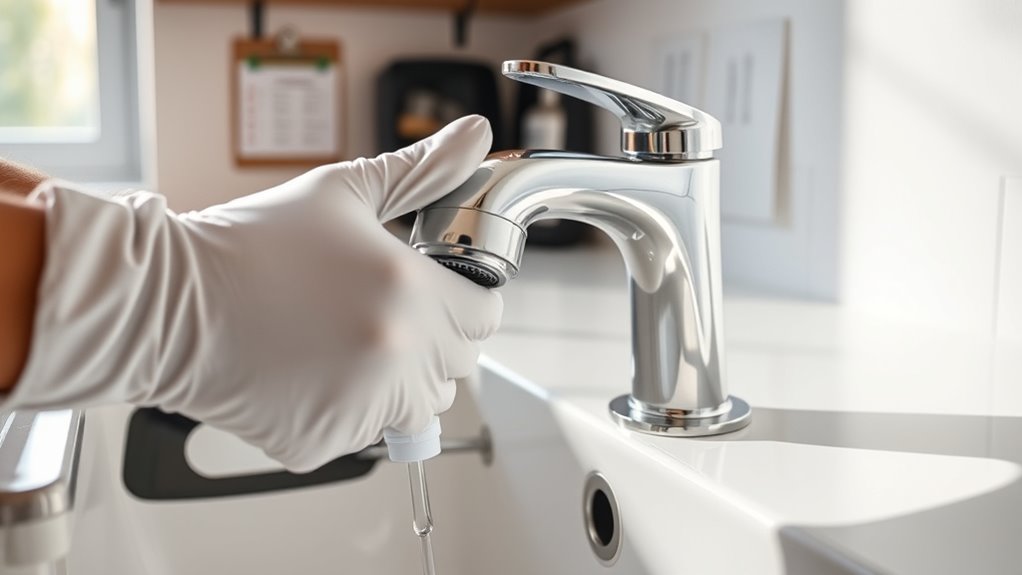
Installing water-efficient fixtures is one of the most effective ways to reduce water consumption at home. Upgrading to low-flow showerheads and faucets cuts water use without sacrificing performance. Consider smart faucet technology, which helps monitor and control water flow, reducing waste. Leak detection devices are also essential; they alert you to hidden leaks that can waste gallons daily.
- Install aerators on faucets to limit flow
- Use smart faucet technology for precise control
- Add leak detection devices for early leak identification
These fixtures and devices work together to optimize water use, saving you money and protecting resources. Make sure to regularly check for leaks and keep fixtures in good condition for maximum efficiency.
Manage Landscape Irrigation Wisely

Efficiently managing your landscape irrigation can substantially reduce water waste and lower your utility bills. Use smart timers and adjust watering schedules based on weather conditions. Incorporate garden mulching to retain soil moisture and minimize evaporation. Replace high-water-use plants with drought-tolerant plants that need less watering. Group plants with similar water needs to avoid over- or under-watering. Regularly check sprinkler heads for leaks or misalignment. Here’s a quick guide:
| Action | Benefit |
|---|---|
| Install smart timers | Precise watering, conserves water |
| Use garden mulching | Keeps soil moist, reduces irrigation needs |
| Plant drought-tolerant plants | Less frequent watering required |
| Adjust schedules seasonally | Avoid overwatering during rain or winter |
| Regular system maintenance | Prevents leaks, ensures efficiency |
This approach helps optimize your irrigation, conserving water effectively.
Educate Household Members on Water Conservation Practices
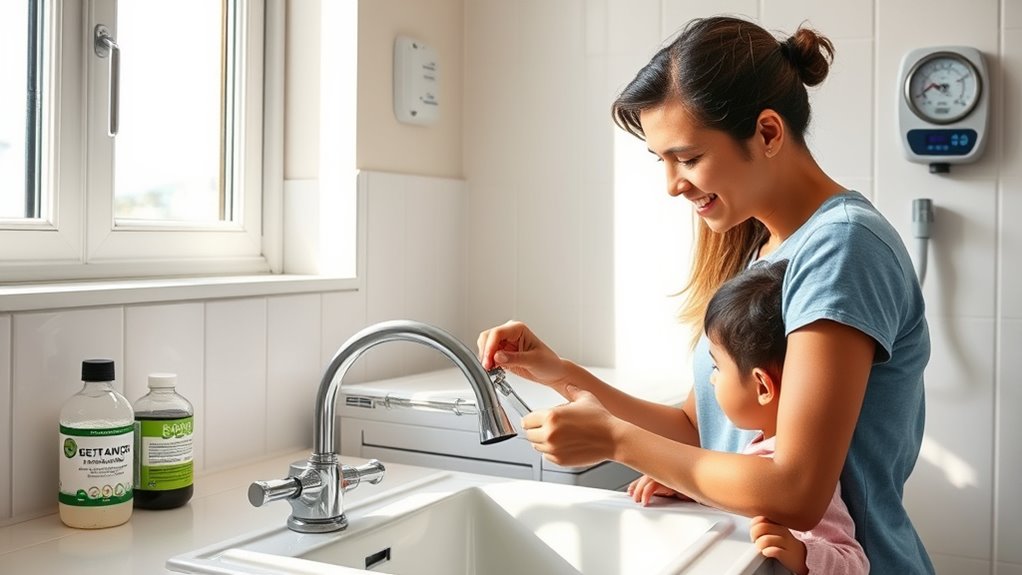
You can start by sharing your water conservation goals with everyone in the household so they understand the importance. Show them how to use fixtures and appliances properly to save water daily. When everyone is informed and involved, conserving water becomes a team effort.
Share Conservation Goals
Have you ever wondered how small changes can make a big difference in water conservation? Sharing your goals with household members encourages teamwork and accountability. Explain how practices like rainwater harvesting and greywater recycling can save water and reduce bills. When everyone understands the benefits, they’re more likely to participate actively. You can:
- Set collective targets for reducing daily water use
- Assign specific conservation tasks, like collecting rainwater
- Share updates on progress to stay motivated
Demonstrate Proper Usage
To effectively conserve water, it is vital to demonstrate proper usage and educate household members on best practices. Showing them proper technique helps everyone adopt water-saving tips consistently. For example, teach family members to turn off taps while brushing teeth or washing dishes. Use the following table to clarify key habits:
| Water Saving Tips | Proper Technique |
|---|---|
| Fix leaks promptly | Check fixtures regularly for drips |
| Shorten shower time | Limit showers to 5 minutes |
| Use full loads in appliances | Only run dishwasher/washing machine when full |
Encouraging awareness and practicing these habits ensures efficient water use. When everyone follows proper technique, your household makes a significant impact on water conservation efforts.
Monitor Your Water Bills and Usage Patterns

Monitoring your water bills and usage patterns is an effective way to identify areas where you might be wasting water. By doing water bill analysis regularly, you can spot unusual spikes or inconsistencies that indicate leaks or inefficiencies. Usage trend monitoring helps you understand when and how you’re using the most water, making it easier to adjust habits accordingly. Keep an eye on your monthly bills for sudden increases, which often point to hidden problems. Additionally, tracking your daily or weekly water use can reveal patterns and opportunities for conservation.
- Check for unexpected bill increases and investigate causes
- Track daily water consumption to identify high-usage periods
- Compare month-to-month data to catch inefficiencies early
Schedule Routine Professional Plumbing Checks
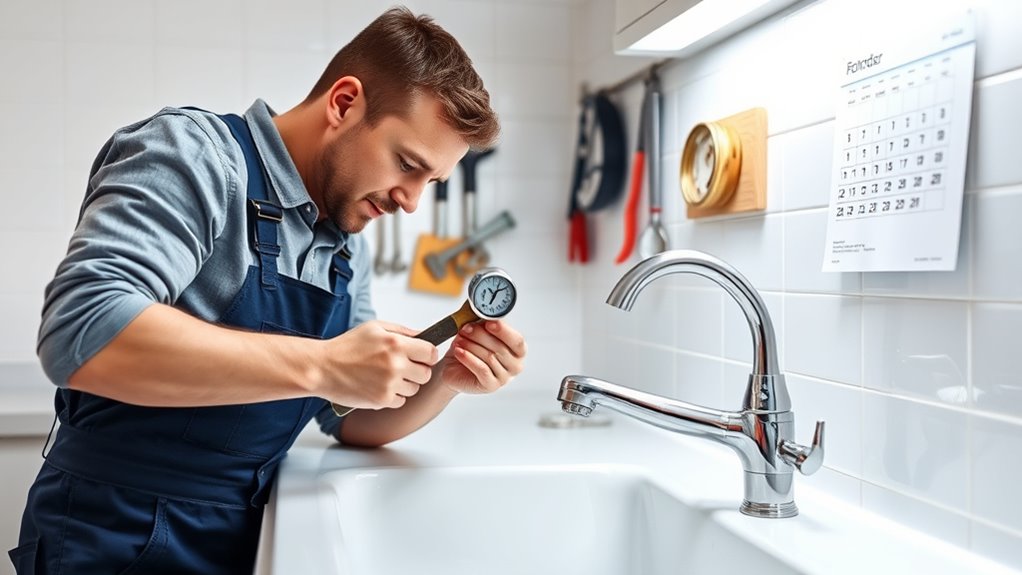
Scheduling routine professional plumbing checks guarantees that hidden leaks and potential issues are caught early before they cause costly damage or water waste. During a plumbing inspection, a professional will carefully examine your pipes, fixtures, and appliances for any signs of wear or leaks. Leak detection techniques help identify hidden leaks that might not be visible but can silently waste water and escalate costs. Regular inspections ensure your plumbing system operates efficiently and helps prevent small problems from turning into major repairs. By scheduling these checks annually or biannually, you stay ahead of potential issues, save water, and extend the lifespan of your plumbing system. Keep your water bill in check and avoid unexpected emergencies with proactive professional plumbing checks.
Frequently Asked Questions
How Can I Detect Hidden Leaks in My Plumbing System?
To detect hidden leaks in your plumbing system, start by checking your water meter—turn off all fixtures and see if it moves, indicating a leak. Inspect pipe insulation for dampness and look for unexplained increases in your water bill. Tighten valves gently to prevent leaks from loosening. Regularly monitor your plumbing for signs of moisture or corrosion, and consider professional leak detection if you’re unsure.
What Are the Signs of Water Pressure Problems at Home?
You might notice water pressure problems at home through pressure fluctuations, where the flow suddenly speeds up or slows down. Low pressure can make showers less effective, while high pressure may cause noisy pipes. Valve issues often contribute to these problems, so check if your main valve is fully open or if any pressure-reducing valves need adjustment. Addressing these signs promptly helps prevent further damage and maintains a steady water flow.
Which Water-Efficient Fixtures Provide the Best Savings?
You might think all water-efficient fixtures save equally, but research shows shower heads and faucet aerators offer the best savings. High-efficiency shower heads reduce water use by up to 50%, while aerators on faucets cut flow without sacrificing performance. Investigating flow rate claims reveals that choosing models with lower gallons per minute (GPM) truly maximizes your savings, making these fixtures your best investment for conserving water and lowering bills.
How Often Should I Perform Professional Plumbing Inspections?
You should schedule professional plumbing inspections at least once every two years to guarantee plumbing maintenance and leak prevention. Regular inspections catch issues early, saving water and preventing costly repairs. If you notice frequent leaks, reduced water pressure, or unusual sounds, consider more frequent visits. Staying proactive keeps your plumbing system efficient, conserves water, and extends its lifespan. Don’t wait for problems to escalate—regular inspections are key to effective leak prevention and water savings.
What Are the Most Effective Landscaping Practices to Conserve Water?
You can conserve water effectively by adopting xeriscaping principles and planting drought-tolerant plants, creating a lush landscape that uses minimal water. While vibrant flowers demand constant watering, drought-tolerant plants thrive on less, reducing your water bill and environmental impact. Incorporate mulching and efficient irrigation to maximize savings. This balance between beauty and practicality guarantees your yard stays vibrant without wasting a drop, promoting sustainable landscaping practices effortlessly.
Conclusion
By sticking to these simple maintenance tips, you’ll save water effortlessly—until a leak sneaks past your attention and turns your savings into a costly flood. Ironically, neglecting routine checks can undo all your efforts, wasting more water and money. So, stay vigilant and proactive; otherwise, your water-saving routine might become just another lesson in what not to ignore. After all, a little maintenance today prevents a flood of regrets tomorrow.










